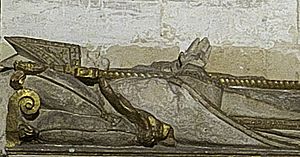Antonio Corrionero facts for kids
Quick facts for kids Most Reverend Antonio Corrionero |
|
|---|---|
| Bishop of Salamanca | |
 |
|
| Church | Catholic Church |
| Diocese | Roman Catholic Diocese of Salamanca |
| In Office | 1621–1633 |
| Predecessor | Francisco Hurtado de Mendoza y Ribera |
| Successor | Cristóbal de la Cámara y Murga |
| Orders | |
| Consecration | 26 April 1615 by Pedro González de Mendoza |
| Personal details | |
| Born | 1554 Babilafuente, Spain |
| Died | 4 April 1633 Salamanca, Spain |
| Previous post | Bishop of Islas Canarias (1614–1621) |
Antonio Corrionero (1554–1633) was an important leader in the Catholic Church. He served as a bishop, which is a high-ranking religious official. He was the Bishop of Salamanca from 1621 to 1633. Before that, he was the Bishop of the Canary Islands from 1614 to 1621.
Antonio Corrionero's Life Story
Antonio Corrionero was born in 1554 in a town called Babilafuente in Spain. He dedicated his life to the church.
Becoming a Bishop
In 1614, Antonio Corrionero was chosen to become the Bishop of the Canary Islands. This important decision was made during the time of Pope Paul V. A pope is the leader of the Catholic Church.
A special ceremony called a consecration took place on April 26, 1615. During this ceremony, he officially became a bishop. Pedro González de Mendoza, who was an archbishop, led the ceremony. Two other bishops, Juan Portocarrero and Luis Fernández de Córdoba, also helped.
Serving in Salamanca
After serving in the Canary Islands, Antonio Corrionero received another important role. In 1621, he was appointed as the Bishop of Salamanca. This appointment happened when Pope Gregory XV was the leader of the church.
He continued to serve the people of Salamanca as their bishop. He held this position until he passed away on April 4, 1633. He died in Salamanca, Spain, where he had served for many years.
See also
 In Spanish: Antonio Corrionero Ruano para niños
In Spanish: Antonio Corrionero Ruano para niños

